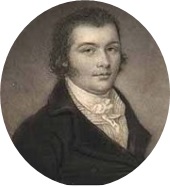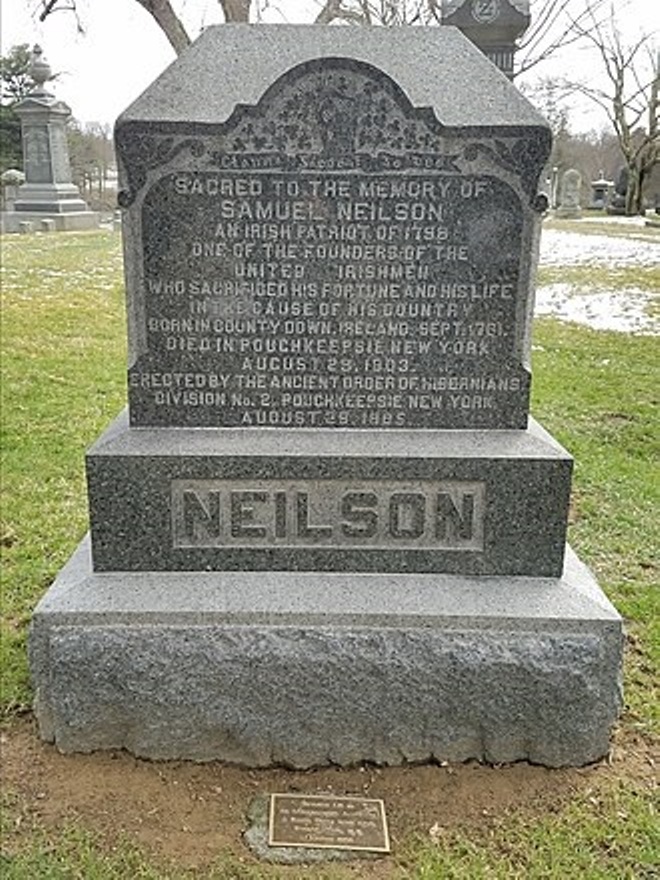Samuel Neilson (1761 - 1803)
Founding Member of the Society of United Irishman,
Editor,
'A Felon of our Land', A victim of imposed
Political Exile
 Samuel Neilson was born on September 17, 1761
in Ballyroney,
Co. Down, Ireland to Alexander Neilson, a Presbyterian
minister, and his wife, Anne Bryson. He was the second son
in a family of eight sons and five daughters. He received a
liberal education locally, excelling in mathematics. At
age 16 years, he started work as an apprentice with his
older brother who ran a woolen drapery business in Belfast.
Samuel Neilson was born on September 17, 1761
in Ballyroney,
Co. Down, Ireland to Alexander Neilson, a Presbyterian
minister, and his wife, Anne Bryson. He was the second son
in a family of eight sons and five daughters. He received a
liberal education locally, excelling in mathematics. At
age 16 years, he started work as an apprentice with his
older brother who ran a woolen drapery business in Belfast.
In 1785 he married Anne Bryson with whom he had five
children, four girls and a boy. After their marriage Samuel
and Anne set up their own business known locally as
"The Irish Woolen Warehouse". The business was very
successful and by 1792, when he became involved in politics,
he had amassed a considerable fortune.
His first involvement in politics was a member of the
reformist Volunteer movement set up to bring about
parliamentary reform. Influenced by the French Revolution,
Thomas Paine's "Rights of Man" and Wolfe Tones
"Argument on Behalf of the Catholics of Ireland" 'he
approached Henry Joy McCracken, a fellow Presbyterian, in
Belfast with the idea of establishing an organization based
on religious equality for the promotion
of Catholic Emancipation and Parliamentary Reform. The idea
was adopted by McCracken and other Presbyterian minded
reformers. In October of 1791 the nine Presbyterian
reformers invited
Wolfe Tone and Thomas Russell, both
Anglicans, to a meeting in
Belfast to discuss the idea of establishing such an
organization. Emanating from that meeting the
Society of United Irishmen was established with Tone as its
titular head. The participants adopted following resolutions as their guiding principles:
That the weight of English influence in the
Government of this country is so great as to
require a cordial union among all the people of
Ireland, to maintain that balance which is
essential to the preservation of our liberties
and the extension of our commerce
That the sole constitutional mode by which
this influence can be opposed is by a complete
and radical reform of the people in Parliament
That no reform is just which does not include
Irishmen of every religious persuasion.
In
January 1792 Neilson became editor of the
Northern Star, the organ of the Society of United Irishmen in the
north whose adage was the radical reform of parliamentary
representation and the repeal of all penal laws against
Catholics. He was one of its major backers, spending a good
portion of his fortune to launch and publish the twice
weekly newspaper. It was one of, if not, the most popular
newspaper of its time. He remained its editor, despite enduring
numerous prosecutions and actions for libel until his arrest
in September 1796 when the newspapers offices were ransacked by the
military, and he, Russell, and several others were arrested
and imprisoned in Newgate prison in Dublin. From there they were
transferred to Kilmainham jail.
The newspaper remained in operation until its printing
presses were destroyed by the Monaghan Militia in 1797.
Along with other prisoners held without charge Neilson was
released in February 1798 on grounds of bad health primarily
resulting from the treatment he received during his
imprisonment.
Conditions of his release forbade him from joining any
treasonable committee or engage in seditious activities.
Resentful of
his treatment while imprisoned and scornful of the British
imposed conditions he immediately joined Lord Edward
Fitzgerald and other leaders of the Society of United Irishmen in
preparing for a rising.
All along the British were kept abreast of the
Society's plans by traitors planted within the leadership of
the Society.
On March 12, 1798, the British, acting on
information providing by the traitor, Thomas
Reynolds, arrested Oliver Bond and fourteen other
delegates assembled in committee in Bond's house in
Dublin.
Neilson and Lord Edward Fitzgerald
were the only figures of national importance still at liberty.
They decided to press ahead with the rebellion as soon as possible and settled
on 23 May as the date for the rebellion to begin.
As with the other betrayed leaders, Fitzgerald's hiding
place in Dublin was raided
On May 18 by the military on information provided
by Francis Higgins the most infamous
traitor of his time. During the raid Fitzgerald was critically wounded while resisting capture.
Neilson, the only top tier leader still at liberty decided
to try and rescue Fitzgerald from Newgate Prison
where he was held.
On the night of May the 23rd, the eve of the planned Rising,
Neilson was arrested outside
Newgate prison, the Irish Bastille, while reconnoitering the
surroundings in preparation for an attack on the prison that
would inaugurate the Rising and liberate Fitzgerald and the
other imprisoned leaders. Unfortunately,
he was well known to
the prison authorities and his presence in the neighborhood
aroused suspicion. After a desperate attempt to avoid
capture by a army patrol he was overpowered, taken
prisoner and lodged in Newgate prison. A account in
the Life of Grattan described Neilson's capture
as follows, "his clothes were torn off him, his
body wounded all over by the soldiers hacking at him, he was
cut and scarred in upwards of fifty places, and was only
saved by the number of his assailants".
On June the 26th, bills of indictment were sent up for high
treason against Neilson and five
other Society leaders. Another account in the Life
of Grattan describes the scene in court to which
Neilson was brought heavily
ironed. "When brought into court the noise of his
entrance was like the march of men in irons. He was called
on to plead, and asked if he had anything to say; he replied
in a stentorian voice, 'No! I have been robbed of
everything—I could not fee counsel; my property—everything
has been taken from me,' and he turned away. But he came again to the front of the dock, and said, 'For myself
I have nothing to say; / scorn your power, and despise that
authority that it shall ever be my pride to have opposed;
but I may say—not that I value it—why am I kept with these
weighty irons on me, so heavy that three ordinary men could
scarcely carry them? Is it your law that I should be placed
in irons, and in such irons?"
After the trial
Neilson was
imprisoned in
Kilmainham jail
with eighty or so other prisoners. To avoid execution the
prisoners agreed to provide information to the English with
respect to their involvement in the Rising with the
understanding that the names of others would not be given. After
interrogating the prisoners the English concluded
that the prisoners had little to add to what they already
knew from their network of spies. In the latter half
of 1798 the prisoners held in Kilmainham were
released except for twenty of the leaders including
Neilson who were
sent to Fort George in
Scotland where they were confined until the
Treaty of Amiens in 1802.
Their transfer
to Fort George was due to the refusal of the Unites
States government to grant Neilson and the
others prisoners permission to emigrate to the U.S. a desire
expressed by them and agreed to by the English. The
decision to deny them entry was orchestrated by
Rufus King the United States ambassador to the Court of St.
James during the John Adams Presidency.
The Treaty of
Amiens marked a lull in the war between the Britain
and France. France included the names of the Irish
prisoners held at Fort George in the list of
prisoners to be exchanged. After an internment of
three plus years Neilson the other
prisoners were released on condition that they never
return to Ireland. On the last day of May in 1802
Neilson was deported to the Netherlands.
After his release from Fort George he wrote a letter to
his friend and fellow United Irishman, Archbald
Hamilton Rowan, in which he described his feelings and
thoughts regarding his efforts on behalf of Irish freedom
with the following words; "Neither
the eight years' hardship I have endured,
the total destruction of my property, the
forlorn state of my wife and children, the
momentary failure of our national exertions,
nor the still more distressing usurpation in
France, have abated my ardour in the cause
of my country and of general liberty. You and I, my dear
friend, will pass away, but truth will remain."
Prior
to his departure for the United States he returned to Ireland in defiance of the British imposed exile, to see his beloved wife and
children and bid farewell to his friends and compatriots.
Samuel
Neilson arrived in the United
States in December of 1802 and settled in Poughkeepsie,
New York. He had little time to enjoy his liberty
before his sudden death on August 29, 1803 of
Yellow Fever, or possibly a stroke. He was
not idle during his short life in America as
he had just completed plans to start a new
evening newspaper in this town of Poughkeepsie and also had plans in the works to establish
a version of the Society of United Irishmen
here in the United States.
Since his
death, he has been moved to three different
cemeteries before coming to rest in the
Poughkeepsie Rural Cemetery in 1880.
Contributed by Tomás Ó Coısdealbha
cemetery
Name:
Poughkeepsie
Rural Cemetery
ADDRESS: 342 South Avenue, Poughkeepsie, NY12601
HEADSTONE

 Samuel Neilson was born on September 17, 1761
in Ballyroney,
Co. Down, Ireland to Alexander Neilson, a Presbyterian
minister, and his wife, Anne Bryson. He was the second son
in a family of eight sons and five daughters. He received a
liberal education locally, excelling in mathematics. At
age 16 years, he started work as an apprentice with his
older brother who ran a woolen drapery business in Belfast.
Samuel Neilson was born on September 17, 1761
in Ballyroney,
Co. Down, Ireland to Alexander Neilson, a Presbyterian
minister, and his wife, Anne Bryson. He was the second son
in a family of eight sons and five daughters. He received a
liberal education locally, excelling in mathematics. At
age 16 years, he started work as an apprentice with his
older brother who ran a woolen drapery business in Belfast.

